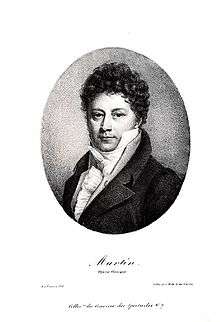Jean-Blaise Martin

Jean-Blaise Martin, full name Nicolas Jean-Blaise Martin[1] (February 24, 1768 in Paris – October 28, 1837 in Tourzel-Ronzières) was a French opera singer whose tessitura lay between tenor and baritone, which became later known as "baryton-martin".
Life and career
Jean-Blaise Martin began singing publicly as a child, before his voice broke. He made his professional operatic debut in 1789, at the Théâtre Feydeau, in Paris, in a parody called Le Marquis de Tulipano. He then studied with Madame Dugazon, and made his debut at the Opéra-Comique in 1794, and sang there until 1823. He became a member of the administrative comity of this theatre in 1801. He also taught at the "Conservatoire de Musique" of Paris, from 1825 to 1837.
He composed one opéra comique, Les oiseaux de mer, produced at the Théâtre Feydeau in 1796.
During his career, he created some 15 roles in operas by Nicolas Dalayrac, François Devienne, André Grétry, Étienne Méhul, Nicolas Isouard, Ferdinando Paer, etc.
Martin's voice was described as a "ténor grave et sombre", meaning a deep-voiced dark tenor, or as a "baryton aigu et clair", meaning a clear-voiced high baritone; the compass was E flat to a, with a falsetto extension to a'. His vocal type became known as "baryton-martin", most often found in French operetta. Modern example of this voice type were French baritone Michel Dens, or closer to us Bernard Sinclair, who can be heard in a few operetta recordings such as La fille de Madame Angot, Les cloches de Corneville, and Valses de Vienne.
In the operatic repertoire, the most famous role for baryton-martin is Pelléas in Claude Debussy's Pelléas et Mélisande. Camille Maurane and Jacques Jansen are widely recognized as having been the best exponents of the role.
Roles created
- 1804: A bard in Ossian, ou Les bardes by Jean-François Le Sueur
- 1821: Barnabé in Le maître de chapelle by Ferdinando Paer
Sources
- Roland Mancini and Jean-Jacques Rouveroux, (orig. H. Rosenthal and J. Warrack, French edition), Guide de l’opéra, Les indispensables de la musique (Fayard, 1995). ISBN 2-213-59567-4
References
- Biography of Jean-Blaise Martin (in German) at Operissimo
- Bernard Sinclair, a baryton-martin (French biography)
|